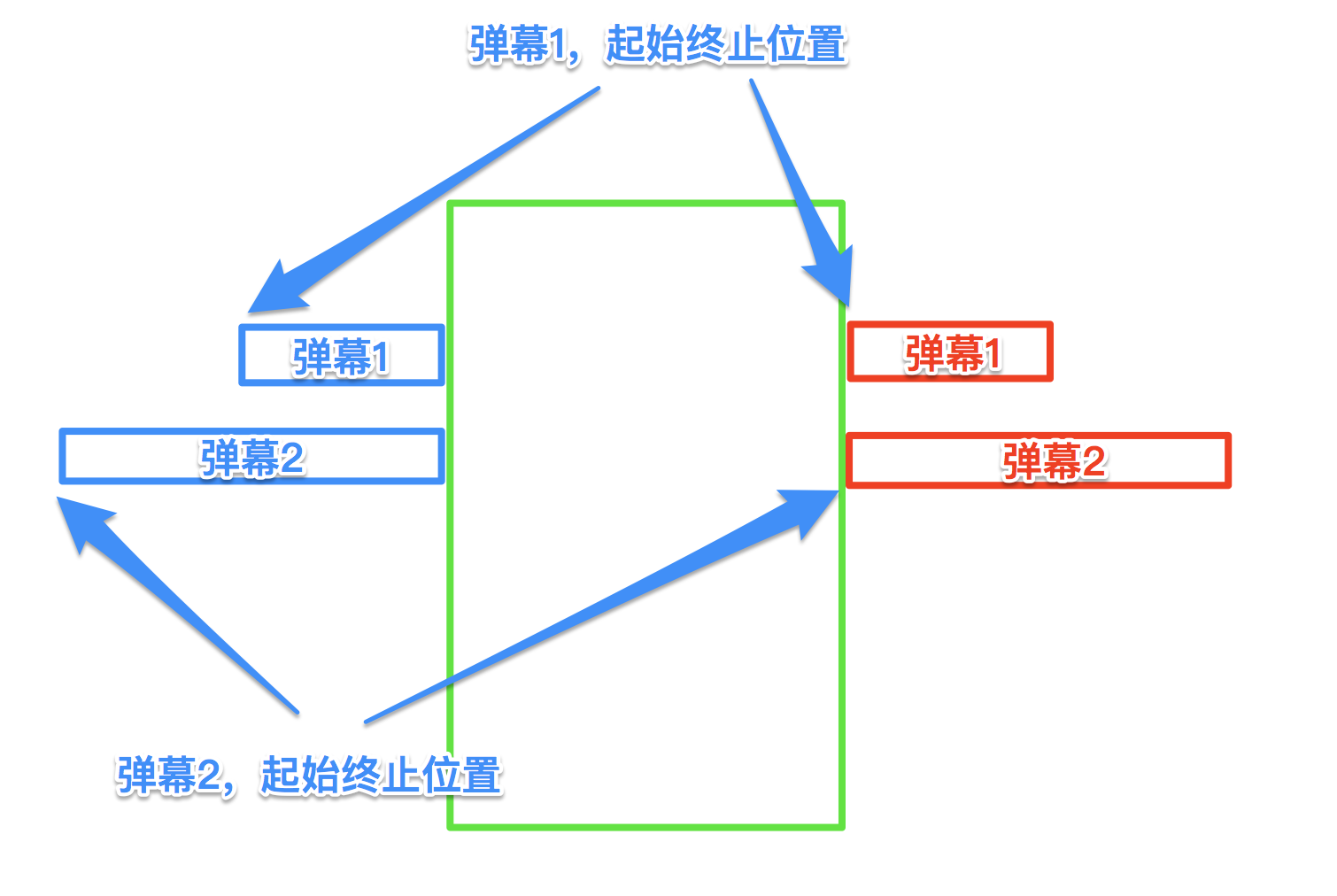这篇文章将为大家详细讲解有关iOS中如何实现视频直播弹幕功能,小编觉得挺实用的,因此分享给大家做个参考,希望大家阅读完这篇文章后可以有所收获。
以下就是全部内容:
1.弹幕的实现性分析
首先,从视觉上明确当前弹幕所具有的功能
从屏幕右侧滑入左侧,直至完全消失
不管是长的弹幕,还是短的弹幕,速度一致(可能有的需求是依据弹幕长度,调整速度)
有弹幕轨道,不是随机产生的弹幕
弹幕不会进行重叠
接下来从功能角度思考需要做什么
重用机制,类似tableView有一个重用池,每个弹幕就是一个cell,当有弹幕发送的时候,如果当前的重用池没有控件,则创建一个新的控件,如果重用池里面有控件,则拿出这个控件,开始做动画,在动画结束后重新将该控件重归重用池。
速度要求一致的话,需要考虑几点,首先如下图所示,红色代表弹幕起始位置,蓝色代表弹幕终止位置,长度代表它们的实际长度。当我们设定动画的时候,采用[UIView animationWithDuration.....]这个动画,设定duration为3s的话那么弹幕1的速度为(屏幕宽度+弹幕1宽度)/3,弹幕2的速度为(屏幕宽度+弹幕2宽度)/3,因为弹幕2长度大于弹幕1的长度,所以弹幕2的速度大于弹幕1的速度。(对于依据弹幕长度调整速度的需求来说,这里相对简单一些,不需要专门去计算速度,唯一麻烦的是需要考虑速度不一致带来的重叠问题)

2.开始准备
精通数学公式V=S/t (V代表速度,S代表路程,t代表时间)(*^__^*)
3.正式开始
创建一个View,命名为BarrageView,以及存储弹幕数据的对象BarrageModel
以下为BarrageModel.h的内容,存储弹幕的头像,昵称,和消息内容
@interface BarrageModel : NSObject
/** 用户昵称 */
@property(nonatomic,copy)NSString *userName;
/** 消息内容 */
@property(nonatomic,copy)NSString *userMsg;
/** 用户头像 */
@property(nonatomic,copy)NSString *userHeadImageUrl;
@end接下来对BarrageView内容进行编辑,注释已经尽可能的详细,因此不多做介绍
在.h文件中
#import <UIKit/UIKit.h>
@class BarrageModel;
@interface BarrageView : UIView
/**
* 记录当前最后一个弹幕View,通过这个View来计算是显示在哪个弹幕轨道上
*/
@property(nonatomic,retain) UIView *lastAnimateView;
/**
* 发送弹幕
*
* @param msgModel 弹幕数据Model
*/
-(void)barrageSendMsg:(BarrageModel *)msgModel;
@end在.m文件中
#import <UIKit/UIKit.h>
@class BarrageModel;
@interface BarrageView : UIView/**
* 记录当前最后一个弹幕View,通过这个View来计算是显示在哪个弹幕轨道上
*/
@property(nonatomic,retain) UIView *lastAnimateView;
/**
* 发送弹幕
*
* @param msgModel 弹幕数据Model
*/
-(void)barrageSendMsg:(BarrageModel *)msgModel;
@end
在.m文件中
#import "BarrageView.h"
#import "BarrageModel.h"
//屏幕的尺寸
#define SCREEN_FRAME [[UIScreen mainScreen] bounds]
//屏幕的高度
#define SCREEN_HEIGHT CGRectGetHeight(SCREEN_FRAME)
//屏幕的宽度
#define SCREEN_WIDTH CGRectGetWidth(SCREEN_FRAME)@interface BarrageView()
{
CGFloat _minSpaceTime; /** 最小间距时间 */
}
/** 数据源 */
@property (nonatomic,retain)NSMutableArray *dataArr;/** 弹幕UI的重用池 */
@property (nonatomic,retain)NSMutableArray *resuingArr;
@end
@implementation BarrageView
- (instancetype)initWithFrame:(CGRect)frame
{
self = [super initWithFrame:frame];
if (self) {
[self setInterface];
}
return self;
}
-(void)setInterface
{
//初始化弹幕数据源,以及重用池
self.dataArr = [NSMutableArray array];
self.resuingArr = [NSMutableArray array];
//创建第一个弹幕加入重用池作为备用
UIView *view = [self createUI];
[self.resuingArr addObject:view];
//设置弹幕数据的初始轮询时间
_minSpaceTime = 1;
//检查是否可以取弹幕数据进行动画
[self checkStartAnimatiom];
}
-(void)checkStartAnimatiom
{
//当有数据信息的时候
if (self.dataArr.count>0) {
if (self.resuingArr.count>0) { //当重用池里面有备用的弹幕UI时
//在重用池中,取出第一个弹幕UI
UIView *view = [self.resuingArr firstObject];
[self.resuingArr removeObject:view];
//取出的这个弹幕UI开始动画
[self startAnimationWithView:view];
}else{ //当重用池没有备用的弹幕UI时
//重新创建一个弹幕UI
UIView *view = [self createUI];
//拿着这个弹幕UI开始动画
[self startAnimationWithView:view];
}
}
//延迟执行,在主线程中不能调用sleep()进行延迟执行
//调用自身方法,构成一个无限循环,不停的轮询检查是否有弹幕数据
dispatch_after(dispatch_time(DISPATCH_TIME_NOW, (int64_t)(_minSpaceTime * NSEC_PER_SEC)), dispatch_get_main_queue(), ^{
[self checkStartAnimatiom];
});
}
-(void)startAnimationWithView:(UIView *)view
{
//取出第一条数据
BarrageModel *barrageModel = [self.dataArr firstObject];
//计算昵称的长度
CGSize nameSize = [barrageModel.userName boundingRectWithSize:CGSizeMake(CGFLOAT_MAX, 14) options:NSStringDrawingUsesLineFragmentOrigin|NSStringDrawingUsesFontLeading attributes:@{ } context:nil].size;
//计算消息的长度
CGSize msgSize = [barrageModel.userMsg boundingRectWithSize:CGSizeMake(CGFLOAT_MAX, 14) options:NSStringDrawingUsesLineFragmentOrigin|NSStringDrawingUsesFontLeading attributes:@{ NSFontAttributeName:[UIFont systemFontOfSize:14]
} context:nil].size;
UIImageView *headImageView; //头像
UILabel *userNameLabel; //昵称
UILabel *userMsgLabel; //消息内容
//进行赋值,宽度适应
for (UIView *subView in view.subviews) {
if (subView.tag == 1000) {
headImageView = (UIImageView *)subView;
headImageView.image = [UIImage imageNamed:@""];
}else if (subView.tag == 1001){
userNameLabel = (UILabel *)subView;
userNameLabel.text = barrageModel.userName;
//重新设置名称Label宽度
CGRect nameRect = userNameLabel.frame;
nameRect.size.width = nameSize.width;
userNameLabel.frame = nameRect;
}else{
userMsgLabel = (UILabel *)subView;
userMsgLabel.text = barrageModel.userMsg;
//重新设置消息内容Label宽度
CGRect msgRect = userMsgLabel.frame;
msgRect.size.width = msgSize.width;
userMsgLabel.frame = msgRect;
}
}
//重新设置弹幕的总体宽度 = 头像宽度 + 头像左右两侧距离 + (如果名字宽度大于消息内容宽度,以名字宽度为基准,如果名字宽度小于消息内容宽度,以消息内容宽度为基准)
view.frame = CGRectMake(SCREEN_WIDTH, 0, CGRectGetWidth(headImageView.frame) + 4 + (CGRectGetWidth(userNameLabel.frame)>CGRectGetWidth(userMsgLabel.frame)?CGRectGetWidth(userNameLabel.frame):CGRectGetWidth(userMsgLabel.frame)), CGRectGetHeight(self.frame));
//不管弹幕长短,速度要求一致。 V(速度) 为固定值 = 100(可根据实际自己调整)
// S = 屏幕宽度+弹幕的宽度 V = 100(可根据实际自己调整)
// V(速度) = S(路程)/t(时间) -------> t(时间) = S(路程)/V(速度);
CGFloat duration = (view.frame.size.width+SCREEN_WIDTH)/100;
//最小间距运行时间为:弹幕从屏幕外完全移入屏幕内的时间 + 间距的时间
_minSpaceTime = (view.frame.size.width + 30)/100;
//最后做动画的view
_lastAnimateView = view;
//弹幕UI开始动画
[UIView animateWithDuration:duration delay:0 options:UIViewAnimationOptionCurveLinear animations:^{
//运行至左侧屏幕外
CGRect frame = view.frame;
view.frame = CGRectMake(-frame.size.width, 0, frame.size.width, frame.size.height);
} completion:^(BOOL finished) {
//动画结束重新回到右侧初始位置
view.frame = CGRectMake(SCREEN_WIDTH, 0, 0, CGRectGetHeight(self.frame));
//重新加入重用池
[self.resuingArr addObject:view];
}];
//将这个弹幕数据移除
[self.dataArr removeObject:barrageModel];
}
#pragma mark public method
-(void)barrageSendMsg:(BarrageModel *)msgModel{
//添加弹幕数据
[self.dataArr addObject:msgModel];
}
#pragma mark 创建控件
-(UIView *)createUI
{
UIView *view = [[UIView alloc] initWithFrame:CGRectMake(SCREEN_WIDTH, 0, 0, CGRectGetHeight(self.frame))];
view.backgroundColor = [UIColor colorWithWhite:0 alpha:0.3];
UIImageView *headImageView = [[UIImageView alloc] initWithFrame:CGRectMake(2, 2, CGRectGetHeight(self.frame)-4, CGRectGetHeight(self.frame)-4)];
headImageView.layer.cornerRadius = headImageView.frame.size.width/2;
headImageView.layer.masksToBounds = YES;
headImageView.tag = 1000;
headImageView.backgroundColor = [UIColor redColor];
[view addSubview:headImageView];
UILabel *userNameLabel = [[UILabel alloc] initWithFrame:CGRectMake(CGRectGetMaxX(headImageView.frame) + 2, 0, 0,14)];
userNameLabel.font = [UIFont systemFontOfSize:14];
userNameLabel.tag = 1001;
[view addSubview:userNameLabel];
UILabel *userMsgLabel = [[UILabel alloc] initWithFrame:CGRectMake(CGRectGetMaxX(headImageView.frame)+2, CGRectGetMaxY(userNameLabel.frame), 0, 14)];
userMsgLabel.font = [UIFont systemFontOfSize:14];
userMsgLabel.tag = 1002;
[view addSubview:userMsgLabel];
[self addSubview:view];
return view;
}最后在vc里面
#import "ViewController.h"
#import "BarrageView.h"
#import "BarrageModel.h"
//屏幕的尺寸
#define SCREEN_FRAME [[UIScreen mainScreen] bounds]
//屏幕的高度
#define SCREEN_HEIGHT CGRectGetHeight(SCREEN_FRAME)
//屏幕的宽度
#define SCREEN_WIDTH CGRectGetWidth(SCREEN_FRAME)
@interface ViewController ()
/** 第一个弹幕轨道 */
@property (nonatomic,retain)BarrageView *barrageViewOne;
/** 第二个弹幕轨道 */
@property (nonatomic,retain)BarrageView *barrageViewTwo;
@end
@implementation ViewController
- (void)viewDidLoad {
[super viewDidLoad];
//创建第一个弹幕轨道
_barrageViewOne = [[BarrageView alloc]initWithFrame:CGRectMake(0,200, SCREEN_WIDTH, 34)];
[self.view addSubview:_barrageViewOne];
//创建第二个弹幕轨道
_barrageViewTwo = [[BarrageView alloc]initWithFrame:CGRectMake(0,300, SCREEN_WIDTH, 34)];
[self.view addSubview:_barrageViewTwo];
}
-(void)touchesBegan:(NSSet<UITouch *> *)touches withEvent:(UIEvent *)event
{
NSTimer *timer = [NSTimer scheduledTimerWithTimeInterval:1 target:self selector:@selector(sendMessage) userInfo:nil repeats:YES];
[timer fire];
}
-(void)sendMessage
{
BarrageModel *model = [[BarrageModel alloc]init];
model.userName = @[@"张三",@"李四",@"王五",@"赵六",@"七七",@"八八",@"九九",@"十十",@"十一",@"十二",@"十三",@"十四"][arc4random()%12];
model.userMsg = @[@"阿达个人",@"都是vsqe12qwe",@"胜多负少的凡人歌",@"委屈翁二群二",@"12312",@"热帖柔荑花",@"发彼此彼此",@"OK泼墨",@"人体有图图",@"额外热无若无",@"微软将围"][arc4random()%11];
//计算当前做动画的弹幕UI的位置
CGFloat onePositon = _barrageViewOne.lastAnimateView.layer.presentationLayer.frame.size.width + _barrageViewOne.lastAnimateView.layer.presentationLayer.frame.origin.x;
//计算当前做动画的弹幕UI的位置
CGFloat twoPositon = _barrageViewTwo.lastAnimateView.layer.presentationLayer.frame.size.width + _barrageViewTwo.lastAnimateView.layer.presentationLayer.frame.origin.x;
if ( onePositon < twoPositon ) {
[_barrageViewOne barrageSendMsg:model];
}else{
[_barrageViewTwo barrageSendMsg:model];
}
}
@end关于“iOS中如何实现视频直播弹幕功能”这篇文章就分享到这里了,希望以上内容可以对大家有一定的帮助,使各位可以学到更多知识,如果觉得文章不错,请把它分享出去让更多的人看到。
亿速云「云服务器」,即开即用、新一代英特尔至强铂金CPU、三副本存储NVMe SSD云盘,价格低至29元/月。点击查看>>
免责声明:本站发布的内容(图片、视频和文字)以原创、转载和分享为主,文章观点不代表本网站立场,如果涉及侵权请联系站长邮箱:is@yisu.com进行举报,并提供相关证据,一经查实,将立刻删除涉嫌侵权内容。